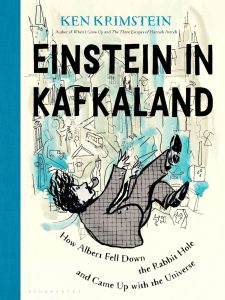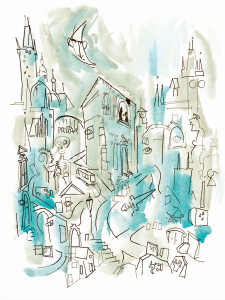KEN KRIMSTEIN postulates the whimsical in EINSTEIN IN KAFKALAND
To read a work from cartoonist Ken Krimstein is to be swept into whimsical worlds of imaginative yesteryear. With a knack for finding the pathos in the phenomenal and the metaphysical in the mundane, there is a unique joy in settling into a Krimstein original.
In his latest book, Einstein in Kafkaland: How Albert Fell Down the Rabbit Hole and Came Up with the Universe (Bloomsbury), Krimstein yet again brings his signature mix of astute insights into the human condition, deep historical awareness, and visual storytelling panache to explore the unexpected intersection of two intellectual giants: the eponymous cultural titans Albert Einstein and Franz Kafka. Known for his New Yorker cartoons and graphic biographies like The Three Escapes of Hannah Arendt, which was a finalist for the National Jewish Book Award, Krimstein consistently captivates audiences with his literary expertise to make complex ideas engaging and easily accessible. Another of his earlier works, When I Grow Up: The Lost Autobiographies of Six Yiddish Teenagers, further showcases his talent for blending history with personal narrative, bringing forgotten voices and stories to life in a way that resonates deeply with readers.
THE BEAT was fortunate to sit down with Krimstein and delve into the inspiration behind his latest project, how his passion for both science and literature guided his exploration of Einstein and Kafka’s lives and the challenges of weaving together their disparate worlds into a cohesive and compelling graphic narrative.

AJ FROST: Hi Ken. Thank you for taking the time to chat with me about your new graphic novel. I wanted to start by asking what inspired you to combine the worlds of Albert Einstein and Franz Kafka in the first place? How did you find the connection between the two?
KRIMSTEIN: I have always been intrigued by Albert Einstein, like just about everyone else I suppose. Especially his whacky, to my mind, theories. My work explores the intersection of the everyday life of great thinkers and their thoughts — how does what they had for breakfast or the bus they took to work impact their creativity? I also had a hunch that Einstein was in many ways as much an artist as a scientist. He was certainly an obsessive musician, he always said he thought visually.
I’ve also been wanting to do a double-biography. My first thought, Einstein and the artist Paul Klee. So many parallels — same age, both played violin, Switzerland and Munich. But as I started researching that angle, I saw that Kafka and Einstein rubbed shoulders in Prague, they were part of the same circle — the salon of Berta Fanta — and several writers (including a biographer who knew them both) drew the line between them. Holy Shit! You can’t make this stuff up! With all due respect, Klee took a back seat and my story set out to answer the eternal question of [what the heck]?!
FROST: So how did these two figures catch your interest? Do you have a personal connection to the themes explored in your book?
KRIMSTEIN: As I said above, despite the fact that I never took physics, and bunked out of pre-med after an unfortunate encounter with calculus in college, I am a science (especially history of science) freak. Kuhn’s book, The Structure of Scientific Revolutions has always been a favorite. As a writer and an artist, Kafka is simply unavoidable. And what’s more, as I was diving into the research, the full catalog of Kafka’s drawings were coming to light — Yale University Press published an amazing collection — Kafka the Karstoonist! Krazy!


FROST: How did you navigate the challenge of intertwining Einstein’s logical, scientific mind with Kafka’s often surreal and enigmatic storytelling style in a cohesive narrative? How did you find the pathway to incorporate elements of each of their lives into your narrative? What specific symbols do you feel best represent the central themes of your book?
KRIMSTEIN: This is an excellent question. Two “things” came to my rescue. 1) Alice in Wonderland and 2) The 600-year-old astronomical clock that towers over Prague’s Old Town Square. Alice — well, Carroll/Dodson has always been of interest, “The Annotated Alice — by Gardner” always fascinated me. And again, as I dipped into Alice’s Adventures I was struck by her “fall” into the rabbit hole, with its strange falling AND standing still episode anticipated so much of Einstein’s thinking — by almost 70 years! WEIRD. And how to weave it all together — having encamped to Prague during a lull in the pandemic, I immediately visited the chiming of the clock — and when I saw that skeleton come out and ring the hours, directly over the house where Einstein and Kafka met in 1911, well, as I had the skeleton say in the book, “From my vantage point, I’ve seen it all.” How could I deny him (or her?) the opportunity to narrate the tale?!
FROST: Can you walk me through your process for the book? How did you approach blending historical facts with the surreality of Kafka’s and the scientific breakthroughs of Einstein? What philosophical queries did you seek to explore through the juxtaposition of Einstein’s theories and Kafka’s existential themes?
KRIMSTEIN: I paid a pilgrimage to Prague. I had been there before, and had to revisit — it is a gnarly, wonderful, perplexing, magical geography — and in all my work, maximizing the power of pictures and words together, I’ve found my method is what I call GEOGRAPHY IS DESTINY. I did copious research — checking out bags full of Einstein books. And I had the delight of rereading Kafka. I contacted writers and professors who authored books on Einstein and Kafka and had many coffees and a couple of hamburgers with them.
The more I looked, the more I saw that they were both poking at the same thing — as I put it in the book, “the true truth.” These were thoroughly modern, thoroughly bold and curious people who would not settle — it was outside of their bandwidth, so to speak. They would take themselves to the limits of knowledge — and then push themselves even further. Their breakthroughs seemed strangely synchronous to me — art and science in lock-step. I wanted to find out what it was that kick-started them to their breakthrough work during those charmed sixteen months that they ‘rubbed shoulders’ in Prague. What happened that changed the way we see the cosmos out there and the cosmos that lurks between our ears?
FROST: Like Kafka, how did you utilize ambiguity within the confines in your narrative? And how do you think the interdisciplinary discourse between physics and literature in the graphic novel challenges the standard boundaries of genre?
KRIMSTEIN: I’ve always loved how pictures contain meaning that extends beyond strict verbal explanation. Or, to put it like my grandmother might have: “a picture is worth a thousand words.” So it didn’t surprise me that both Einstein and Kafka were, I believe, primarily visual thinkers. Humor, which also thrives on ambiguity, is more than an interest of mine. Through my gag cartoon work, especially in The New Yorker, the divine “ambiguity” of funny puts bread on my table. (And even Dr. Freud took jokes pretty seriously…) Oh, and by the way, Einstein was funny, in a kind of nasty, what we call “snarky” way. It really comes across in his letters. As for physics and literature? I guess the way my mind works — labels are just that. Labels. They lose their adhesiveness over time, fade, and eventually fall off altogether. They are merely “badges,” and as someone once said, “Badges? We don’t need no stinkin’ badges!”
I think the medium, the genre, is particularly suited to delving into complex, bizarre ideas. We can diagram and illustrate, and through the magic of subheads, ironically comment on and even gently — or not so gently — subvert our own message. Meta?* Why not?
FROST: How much research did you do to portray Einstein and Kafka realistically? Were there any challenges you faced in incorporating their stories? And how did you balance the historical context and factual accuracy with creative liberties?
KRIMSTEIN: I do as much research as I can to portray them realistically. I visit their homes. I visit their offices. I took the train from Zurich to Prague, the same line Einstein took, the same stations. I wouldn’t stop until I found out what the strange uniform Einstein was forced to wear at his “induction” looked like, finally finding answers at the State Historical Museum in Vienna. I need to learn about what’s going on in the world at their time, and inhabit, just like they did. For example; a scorching global heat wave, the theft of the Mona Lisa in broad daylight, Thomas Edison’s whirlwind visit to Prague and how Kafka notes it in his diary. On and on. The challenges — there are various descriptions by various historians of their interactions. Reiner Stach, the most eminent Kafka biographer, definitively puts them together, as does Einstein’s colleague in Prague, Phillip Frank.
As I say in the book, all the actual incidents — papers, theories, articles, letters — conform to actual documented events. I use storytelling (and story-showing) to probe into the emotional and creative threads. Another guiding principle of all my work comes directly from the mouth of Hannah Arendt, the subject of my first biography: “Storytelling reveals meaning without committing the error of defining it.” I am interested in the meaning.
FROST: How did the interaction between your roles as both writer and artist influence the creative process? Were there instances where the visual elements determined the direction of the story or vice versa?
KRIMSTEIN: I see my role as writerartist — or possibly, artistwriter. They are completely wedded in my mind (and hand.) My practice was honed not only in making New Yorker-style cartoons, but in making print ads, influenced by the early 1960s work coming out of the Doyle Dane Bernbach agency. I am a firm believer in the equation 1 + 1 = 3. (Visuals and verbals shouldn’t illustrate each other, they should leave a space for the reader/viewer to enter the work — so they ENGAGE with it. (Truth be told, that equation may provide a clue to my troubles with calculus…)
Visual elements — especially the overall tone and feel — determine the overall tone. And tone determines how the story will be told. In this case, I decided to go completely analog — I painted every page with ink and Dr. Martin’s Ice Blue dye on 300 lb. Hot Press D’arches watercolor paper.
Also, whenever I could find a visual that would “eat up” words — I’d use it. As I mentioned above, I had the “see and say” disease beaten out of me during my years working on Madison Avenue!
FROST: Thinking broadly: do you think Einstein in Kafkaland serves as a platform for philosophical inquiry, particularly in exploring themes of existentialism, the absurd, and humanity’s search for meaning?
KRIMSTEIN: I certainly hope so! My books are my take on history — my hope is that by sparking a connection with the people and the work, my readers/viewers will dive deeper into the primary sources themselves. That’s why I provide such an exhaustive, though by no means complete, list of sources in the appendix. I see my audience as collaborators. This is my take, what’s yours?
FROST: Were there any moments or scenes in the book that were especially emotionally impactful for you?
KRIMSTEIN: I had an enormous amount of sympathy for the character of Paul Ehrenfest, Einstein’s great friend, and yet another itinerant Jewish physicist bouncing his way from university to university, a musician and a huge inspiration to Einstein. Likewise, Max Abraham, another tragic, colorful inspiration to the young Albert. I had to wrestle with the legacy of Einstein’s first wife, Mileva Maric — the source of much controversy regarding her contributions to Einstein’s theories, but also, possibly, the love of his life. When I discovered the depth of their relationship, and their hidden tragedy, I knew I had to find a way to allow her voice to be heard, and that forced me to dig deep.


FROST: Can you share any insights into your future projects? Are there any more historical or literary figures you’re interested in exploring?
KRIMSTEIN: I love what my “craft,” my “practice” allows me to do — to create a “Time Machine” that busts us into the brains and hearts and streets of people from the past. I have toyed with the idea of pure fiction, but again, badges really blur for me. From what I can tell, it’s a very blurry line between storytelling and what passes for REALITY. I am looking at more contemporary figures, and also, at historical events and characters that, believe it or not, I actually had a small (infinitesimal?) part in.
Besides trying to answer that primal question I posed above — WTF!!?? — to make the cut, so to speak, the stories I want to show and tell also have to offer the possibility of making lots and lots of cool drawings.
FROST: Thank you so much for your time!
Einstein in Kafkaland: How Albert Fell Down the Rabbit Hole and Came Up with the Universe is available now. Learn more about Ken and his work at his website.
*NOT THE COMPANY! THE CONCEPT…
Source link

